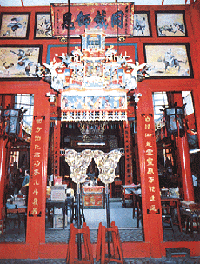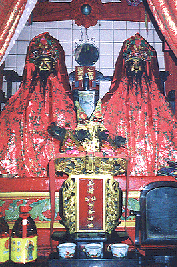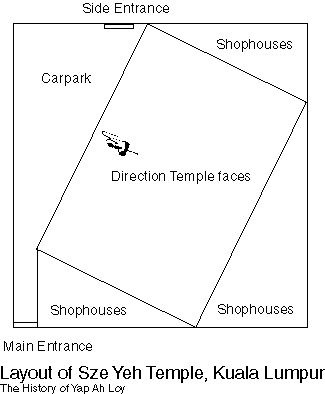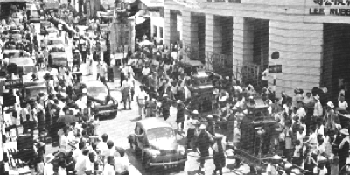The
Sin Sze Si Ya
Temple of Kuala Lumpur! The Sin Sze Si Ya
Temple is one of the few remaining buildings or monuments
that still remind people of the trials and tribulations
that Yap Ah Loy faced during the early history of Kuala
Lumpur.
|

|
|
The interior of the temple. |
|

|
The effigies of Shin Kap
(R)
and Chong Piang (L). |
The temple was first built by Yap Ah Loy in
the 1864 in honour of the famous Kapitan Shin Kap of
Sungei Ujong (present day Seremban) whom Yap Ah Loy had
worked for before and during the Sungei Ujong conflict in
1859. During this conflict, Kapitan Shin’s hurriedly
assembled force was defeated and Kapitan Shin himself was
beheaded after being captured by the opposing Malay
forces. His death was extraordinary in that the blood
that gushed out after his head was chopped off was white
and not red. In Malay belief, the spilling of white blood
by a dying person indicates that the person is a saint.
When the Malays saw this, they begged for forgiveness and
allowed the Chinese to retrieve his body for burial. As a
result of Kapitan Shin’s miraculous death, the local
Chinese began to worship him as a deity and he became the
guardian deity for Chinese miners in Malaya.
It was
said that Kapitan Shin had appeared to Yap Ah Loy in a
dream telling him to go to Kuala Lumpur where he would
have better prospects. Perhaps it was due to this dream
or that Yap Ah Loy had heard stories that Kuala Lumpur
possessed large tin reserves, that he finally decided to
foresake the Sungei Ujong Kapitanship that he had
inherited, and take up Liu Ngim Kong’s (the then
Kapitan Cina of Kuala Lumpur) offer of a position in his
business.
When Yap
Ah Loy succeeded Liu Ngim Kong to become the third
Kapitan Cina of Kuala Lumpur, he relocated Kapitan
Shin’s temple from its original site in Sungei Ujong
to a house in Kuala Lumpur in 1864.
In 1885,
after he had made a fortune from the soaring tin prices,
he relocated the temple to its present site at the north
end of Jalan Petaling in Kuala Lumpur. It was said that
during the Civil War, Kapitan Shin had appeared several
times to Yap Ah Loy in his dreams to give him advice. He
advised Yap Ah Loy to train archers, and that there was a man among his
soldiers who knew how to make rockets with
bamboo and gunpowder.
The
identity of the second effigy is less certain. The
temple's version of the story says that subsequent
to the civil war, Yap Ah Loy added the effigy of Chong
Piang (also known as Chong Sze) alongside Kapitan
Shin’s, as well as tablets of soldiers who perished
in the war, so that people may pay respects to
them.
Chong
Piang was Yap Ah Loy's chief general during the Civil
War, he had repeatedly defeated the opposing forces,
including Syed Mashhor, the famous warrior whom he had
beaten twice. At one time, Syed Mashhor was so distressed
with the fact that he was defeated despite well-planned
war preparations that he attempted to commit suicide.
After the war, before Yap Ah Loy could reward him for the
liberation of Kuala Lumpur, Chong Piang had died.
The other
version says that the effigy represented Yap Ah Sze, who
was murdered in Kanching. Yap Ah Loy probably considered
Yap Ah Sze as a benefactor, as he had declined the offer
to succeed Liu Ngim Kong as the next Kapitan Cina of
Kuala Lumpur after Liu Ngim Kong's death, which paved the
way for Yap Ah Loy's ascension to be the next Kapitan Cina. He, together with Hiu
Siew, were first traders in
Kuala Lumpur, and was already a wealthy merchant, hence
he would have been more favoured for the position.
 The present site
of the temple was chosen after a Chinese medium was consulted, a deity
possessed and spoke through the medium, and promised prosperity and
wealth if a temple were built on the present site. The site of the
temple is reportedly to be a place of good fengshui. The present site
of the temple was chosen after a Chinese medium was consulted, a deity
possessed and spoke through the medium, and promised prosperity and
wealth if a temple were built on the present site. The site of the
temple is reportedly to be a place of good fengshui.
The
temple was the Chinese religious and community center of Kuala Lumpur at
that time. It was the place where the leadership of the Chinese
community held meetings and made important decisions about the
administration of Kuala Lumpur.
The temple is unique in that
the two main deities worshipped were not traditional deities originating
from China, instead two local persons were elevated to the status of
deities based on their merit. Hence, the two deities can be considered
patron deities of the local population of Kuala Lumpur.
The peak
of the popularity of this cult was in the twenty years after Yap Ah Loy’s
death, from 1885 to 1905. To commemorate Kapitan Shin's accession to
become a deity, a procession was held annually through the streets of
Kuala Lumpur, a larger procession was held every 7 years. In the
procession of 1902, the Catholic priest, Father Letissier estimated the
procession to have cost over $100,000 and that the procession took up to
an hour and a half to pass by. The Chinese clans often vied with each
other in their contributions to the procession, and their leaders would
walk at the front of the procession clad in their finest attire. The
original purpose of the cult was no doubt to reassure the immigrant
Chinese that they were protected against diseases and other insecurities
that plagued them in a foreign land.
 |
1956:
The procession weaves through the streets of
Kuala Lumpur.
|
Even today, festivals related to this past
era are still celebrated by devotees in the temple. On
the 15th day of the third moon of the Chinese lunar
calendar, the procession of the deities is observed, but
the procession no longer parades through the streets of
Kuala Lumpur, and is only celebrated within the temple's
compounds. Likewise, remembrance ceremonies for Shin Kap,
Chong Sze (or Chong Piang) and Yap Ah Loy are held
annually in the temple, as well as the paying of respects
to the brave soldiers of the civil war.
The temple
is also known for ite charity work. Since 1907, the
temple has been giving out two thirds of its income
as charity to educational purposes and to
hospitals.
| 
